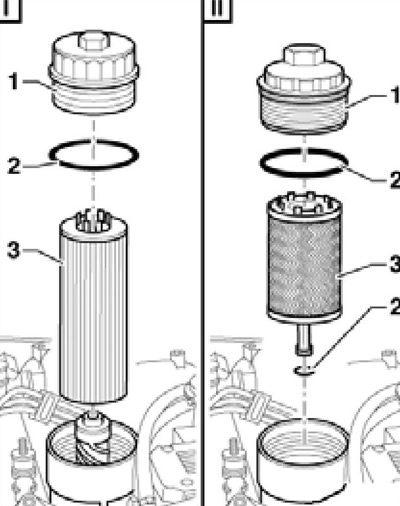Caution: Prolonged skin contact with used motor oil is quite hazardous to health. Use barrier cream or wear rubber gloves during the procedures below.
Note: Frequent engine oil changes are the number one preventive maintenance procedure available to the amateur mechanic. Over time, the oil is susceptible to dilution and contamination, which leads to premature engine wear.
Note: On diesel models and on 3.6L petrol models, the oil filter must be changed before draining the engine oil, as when the filter is removed, the valve opens and the oil from the filter housing flows into the engine sump.
1. Warm up the engine to operating temperature and remove the engine oil filler cap (3 in Section 1 illustrations). Provide access to the oil filter (for example, it may be necessary to disconnect hoses, remove the air cleaner and/or other components).
2. Jack up the car and place it on supports, or drive it into a viewing hole. The vehicle must be level.
3. If installed, remove the sound insulation under the engine compartment (see chapter 11). Unscrew the oil drain plug in the oil pan and let the oil drain into a container placed in advance.
Note: Be careful not to burn yourself with hot oil. Beforehand, you can pump out the oil through the dipstick guide tube.
4. On petrol models with a fully replaceable filter, unscrew the oil filter (see Chapter 2, Section "Working with the lubrication system") using a band wrench or a suitable large polyhedral wrench. Clean the sealing surfaces of the filter and engine, lubricate the O-ring of the new filter with clean engine oil and screw it into the engine by hand. Then tighten the filter to the force specified in the Specifications.
5. On 3.6L petrol models, with the filter element installed in a separate housing, loosen the plug (1 per resist. illustrations) drain hole and collect the oil. Then turn the cover (3) oil filter and replace the filter element (4) with sealing rings (2). Tighten the stopper (1) with a force of 10 Nm.

6.5 3.6L gasoline engine filter element installation details
6. On diesel models, the filter element is installed in a separate housing. Before replacing it on TDI-CR engines, the bolt must be unscrewed (arrow in illustration 6.6a), release the wire (2), unhook the solenoid valve (1) with holder, and lay them aside to allow access to the cover of the filter element mounted on the front side of the engine. On all diesel engines, remove the cover (1 in illustration 6.6b) oil filter housing with a 32 or 36 mm wrench, remove the filter element (3) and replace o-rings (2), by lubricating the new rings with oil. Make sure that there are no foreign particles in the filter housing, clean the mating surfaces of the cover and filter housing. Install a new filter element and tighten the cap to 25 Nm. Fasten the solenoid valve and wire.

6.6a Solenoid valve above the cover of the filter element of diesel models TDI-CR

6.6b Installation details of the filter element of diesel engines
7. Tighten the new oil drain plug to 30 Nm. Note: The seal does not separate from the plug, so the plug must be replaced with the seal.
8. Fill with engine oil and tighten the filler plug (see Section 4).
9. Start the engine and let it run at idle speed until the engine oil low pressure switch turns off (see Chapter 13 "Controls and methods of operation"). An increase in speed with a burning K / L of low pressure of impellent oil can lead to failure of the turbocharger (if available).
10. Wait 3-5 minutes and check the engine oil level, correct it again if necessary.
11. Drive the vehicle for a test drive and check the drain plug and oil filter for leaks. If necessary, slightly tighten the plug and/or filter. Check the oil level again, correct if necessary.
